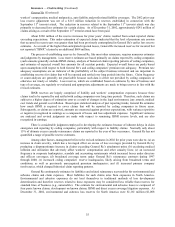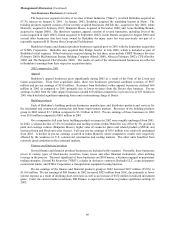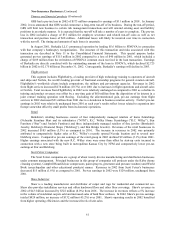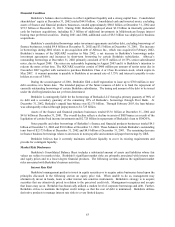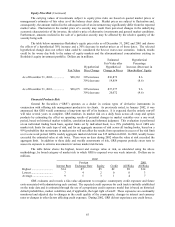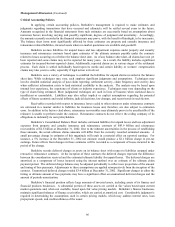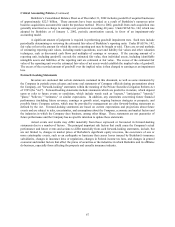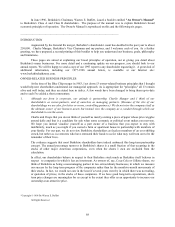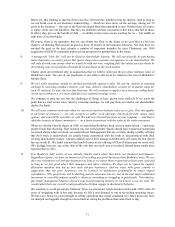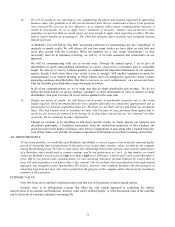Berkshire Hathaway 2002 Annual Report Download - page 64
Download and view the complete annual report
Please find page 64 of the 2002 Berkshire Hathaway annual report below. You can navigate through the pages in the report by either clicking on the pages listed below, or by using the keyword search tool below to find specific information within the annual report.63
Financial Condition
Berkshire’ s balance sheet continues to reflect significant liquidity and a strong capital base. Consolidated
shareholders’ equity at December 31, 2002 totaled $64.0 billion. Consolidated cash and invested assets, excluding
assets of finance and financial products businesses, totaled approximately $80.8 billion at December 31, 2002 and
$72.5 billion at December 31, 2001. During 2002, Berkshire deployed about $3.9 billion in internally generated
cash for business acquisitions, including $1.3 billion of additional investments in MidAmerican Energy interest
bearing trust preferred securities. During 2001 and 2000, additional cash of $8.5 billion was deployed in business
acquisitions.
Berkshire’ s consolidated borrowings under investment agreements and other debt, excluding borrowings of
finance businesses, totaled $4.8 billion at December 31, 2002 and $3.5 billion at December 31, 2001. The increase
in borrowings during 2002 relates to pre-acquisition debt of Albecca Inc., which was acquired in February 2002,
Berkshire’ s issuance of the SQUARZ securities in May 2002, a net increase in Berkshire’ s borrowings under
investment agreements and increases in short-term borrowing by certain Berkshire subsidiaries. Albecca’ s
outstanding borrowings at December 31, 2002 primarily consisted of $135 million of 10.75% senior subordinated
notes, due in August 2008. The notes are redeemable beginning in August 2003 and it is Berkshire’ s intention to
redeem the notes at that time. The SQUARZ securities consist of $400 million par amount of senior notes due in
November 2007 together with warrants to purchase Berkshire Class A or Class B common stock, which expire in
May 2007. A warrant premium is payable to Berkshire at an annual rate of 3.75% and interest is payable to note
holders at a rate of 3.00%.
During the second quarter of 2001, Berkshire filed a shelf registration to issue up to $700 million in new
debt securities at a future date. The intended purpose of the future issuance of debt is to fund the repayment of
currently outstanding borrowings of certain Berkshire subsidiaries. The timing and amount of the debt to be issued
under the shelf registration has not yet been determined.
Berkshire is contingently liable for the borrowings of Berkadia LLC through a primary guaranty of 90% of
its debt and a secondary guaranty of the remaining 10% of Berkadia’ s borrowings through Fleet Bank. At
December 31, 2002, Berkadia’ s unpaid loan balance was $2.175 billion. Through February 2003, the loan balance
was subsequently reduced through prepayments to $1.725 billion.
Assets of the finance and financial products businesses totaled $33.6 billion at December 31, 2002 and
$41.6 billion at December 31, 2001. The overall decline reflects a decline in assets of BH Finance as a result of the
liquidation of certain fixed income investments and $2.725 billion in repayments of Berkadia’ s loan to FINOVA.
Notes payable and other borrowings of Berkshire’ s finance and financial products businesses totaled $4.5
billion at December 31, 2002 and $9.0 billion at December 31, 2001. These balances include Berkadia’ s outstanding
term loan of $2.175 billion at December 31, 2002 and $4.9 billion at December 31, 2001. The remaining decrease
in finance business borrowings relates to decreases in notes payable and commercial paper borrowings by GRS.
Berkshire believes that it currently maintains sufficient liquidity to cover its existing requirements and
provide for contingent liquidity.
Market Risk Disclosures
Berkshire's Consolidated Balance Sheet includes a substantial amount of assets and liabilities whose fair
values are subject to market risks. Berkshire's significant market risks are primarily associated with interest rates
and equity prices and to a lesser degree financial products. The following sections address the significant market
risks associated with Berkshire's business activities.
Interest Rate Risk
Berkshire's management prefers to invest in equity securities or to acquire entire businesses based upon the
principles discussed in the following section on equity price risk. When unable to do so, management may
alternatively invest in bonds, loans or other interest rate sensitive instruments. Berkshire's strategy is to acquire
securities that are attractively priced in relation to the perceived credit risk. Management recognizes and accepts
that losses may occur. Berkshire has historically utilized a modest level of corporate borrowings and debt. Further,
Berkshire strives to maintain the highest credit ratings so that the cost of debt is minimized. Berkshire utilizes
derivative products to manage interest rate risks to a very limited degree.




